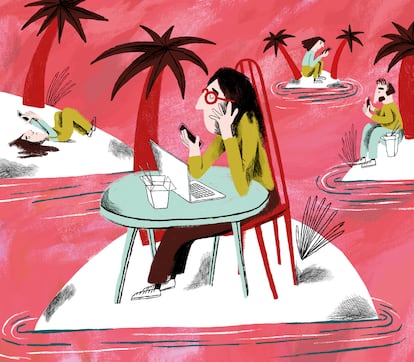Remote work, takeout, binge-watching TV... Are we becoming more antisocial?
Spending too much time at home can increase the risk of isolation

More and more people walk down the street absorbed in their cellphones. We know more about Trump than about what’s happening to our friends. Talking with neighbors is becoming less common, and we are unable to strike up conversations with strangers on the subway or train. An article in The Atlantic describes how, in the U.S., people are becoming increasingly antisocial. More people are working from home, spending more time in front of screens, going out with friends less, attending the cinema less often, and even dating less. What’s more, they prefer ordering food delivery over eating out, and being single is on the rise, as is the time spent on self-care rather than helping others outside their close family circle. The conclusion is clear: self-imposed loneliness could become one of the most pressing social issues of the 21st century.
In Spain, the data shows a similar trend: more time at home, intensive use of digital devices, and a shift in traditional ways of socializing. This poses the risk of increasing voluntary isolation. Over the past 50 years, the number of people living alone has multiplied eightfold, and this number is expected to keep growing. At the same time, the rate of people who are single — often against their wishes — and the decline in birth rates continue to climb. There’s also been a noted preference for more solitary sports and a decrease in socializing outside the home, partly due to changes brought on by the pandemic and an increasing inclination toward home-based leisure.
The main cause of this growing self-imposed loneliness and increasingly antisocial behavior seems to be the intensive use of technology. Watching series on streaming platforms, scrolling through Tinder, or playing video games have become dominant activities. As adults, we tend to become glued to our phones, which provide fleeting satisfaction. Interactions through social media often replace face-to-face conversations or phone calls, depriving us of true intimacy, which occurs when we interact in person, when our mirror neurons sync up.
This creates a paradox: although a certain level of isolation can be healthy, many people fail to respond to the biological signals that indicate that excessive isolation is harmful. In other words, they don’t react to the evolutionary cue telling us that spending too much time alone is damaging and that the best remedy is to go out and connect with others. Many people believe they aren’t lonely, but in fact, they are. They’ve become people who prefer their home as a private space where there are no intrusions. This phenomenon can lead to mistrust of others, fear of commitment, or seeking isolation as emotional refuge.
The reasons for this behavior, whether conscious or not, are diverse. Sometimes it’s easier to avoid than to face things. Other times, staying in a shallow conversation on the phone is more comfortable than engaging in a deep one. Fear of rejection paralyzes many more than the desire to connect.
At times, the emotional overload and stress of everyday life push us to seek a retreat — a space to disconnect from a world overloaded with stimuli. Laura Coll-Planas, from the University of Vic–Central University of Catalonia, points out in an article that social distrust fuels this tendency to choose isolation over the risk of interaction. This optional isolation, in many cases, isn’t driven by rational thought nor is it a conscious decision, rather, often, after conflicts, people, disillusioned, choose to withdraw from the world.
However, the problem is that many of these people don’t really want to be alone; rather, they are following the ideas imposed by a culture of individualism. Today’s society promotes the idea that “it’s best to be alone” or that “you don’t need anyone.” This emphasis on excessive self-care has created the belief that dependency and commitment are unnecessary.
What we need is the opposite: to interact with others, expose ourselves to situations that challenge and frustrate us in order to grow. It’s time to return to the complexity of relationships without falling into the simplification of virtual ones; to embrace the complexity with everything it entails, such as learning to manage frustration, disagreements, and conflicts. We cannot expect this to happen if we choose to spend too much time alone at home. In doing so, we miss out on valuable opportunities, even opportunities for happiness.
Social relationships protect us from chronic stress. We need to regain social habits, like going for walks with friends, playing sports in a group, talking with neighbors, making eye contact on the subway, volunteering, having fun with board games, knitting in company, and above all, seeing each other face to face — looking at one another, smiling, talking about daily life, about what matters to us, having real conversations. We all need to feel part of something bigger, whether in a social or community sense. Our family, friends, and coworkers depend on us. And we depend on them.
Sign up for our weekly newsletter to get more English-language news coverage from EL PAÍS USA Edition
Tu suscripción se está usando en otro dispositivo
¿Quieres añadir otro usuario a tu suscripción?
Si continúas leyendo en este dispositivo, no se podrá leer en el otro.
FlechaTu suscripción se está usando en otro dispositivo y solo puedes acceder a EL PAÍS desde un dispositivo a la vez.
Si quieres compartir tu cuenta, cambia tu suscripción a la modalidad Premium, así podrás añadir otro usuario. Cada uno accederá con su propia cuenta de email, lo que os permitirá personalizar vuestra experiencia en EL PAÍS.
¿Tienes una suscripción de empresa? Accede aquí para contratar más cuentas.
En el caso de no saber quién está usando tu cuenta, te recomendamos cambiar tu contraseña aquí.
Si decides continuar compartiendo tu cuenta, este mensaje se mostrará en tu dispositivo y en el de la otra persona que está usando tu cuenta de forma indefinida, afectando a tu experiencia de lectura. Puedes consultar aquí los términos y condiciones de la suscripción digital.
More information
Archived In
Últimas noticias
Most viewed
- Alain Aspect, Nobel laureate in physics: ‘Einstein was so smart that he would have had to recognize quantum entanglement’
- Mexico’s missing people crisis casts a shadow over World Cup venue
- Why oil has been at the center of Venezuela-US conflicts for decades
- Trump clarifies who is ultimately in charge in Venezuela: ‘Me’
- Mexico seeks to shore up its defenses following US incursion in Venezuela










































